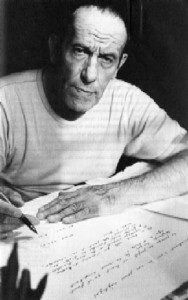 Born in Vaucluse in 1907, René Char was a member of the French surrealist movement and was one the enduring poets of the 20th Century. The fourth born and youngest in a well to do family, his father was the mayor of the district and an influential business man. Most of Char’s early life was spent in the palatial grounds of his family home in Névons.
Born in Vaucluse in 1907, René Char was a member of the French surrealist movement and was one the enduring poets of the 20th Century. The fourth born and youngest in a well to do family, his father was the mayor of the district and an influential business man. Most of Char’s early life was spent in the palatial grounds of his family home in Névons.
His surroundings were rich in nature and the vast countryside of Vaucluse, along with its broad mix of artisans, would form a significant part of his poetry over the following years. In 1918, his father died suddenly and the young Char spent his teens staying at public schools including in Avignon. After a brief spell in Tunisia he joined the army and spent two years in the artillery.
René Char published his first collection, Cloches sur le cœur, in 1928, verses he had been compiling over the previous five year or six years. He became involved in the surrealism when he sent Arsenal, his second poetic collection, to Paul Éluard who was so impressed that he traveled to see Char for a meeting in Nimes.
They became firm friends and Char headed for Paris where he was introduced to the leading lights in the surrealist movement, including Breton. Surrealism grew out of Dadaism and began in the early 1920s with France as its focal point before the movement expanded to the rest of the world.

Shortly after his arrival Char wrote and published Profession de foi du sujet in a surrealist magazine and remained in the movement until the mid-1930s. His poems during this period were illustrated by some of the major artists of the time including Picasso and Matisse.
Char fell in love and married Georgette Goldstein in 1933 and a year later published one of his most well-known works, The Hammer Without a Master. With the political situation in Europe rapidly beginning to change, Char began to distance himself from the surrealist movement and, when war broke out, he joined the French Resistance.
Whilst France was occupied by the Germans, he decided not to publish any more poetry though he worked on several prose works to do with the resistance. The collection was brought together in 1946 and was a critical success. His marriage to Georgette though was beginning to falter and a few years later they divorced.
The 50s and 60s saw Char produce a more mature selection of works including A une sérénité crispée and La Parole en archipel and he also became more political, joining the fight against the government’s placing of nuclear weapons in Provence. In 1960 he narrowly avoided death when there wasn’t enough room in a car that contained author Albert Camus and Michel Gallimard. It later crashed and the occupants were killed, including Camus.

Char continued to write well into his later life, publishing his last collection, Éloge d’une soupçonnée, in 1988, the same year that he died suddenly from a heart attack. He was 80 years old.

